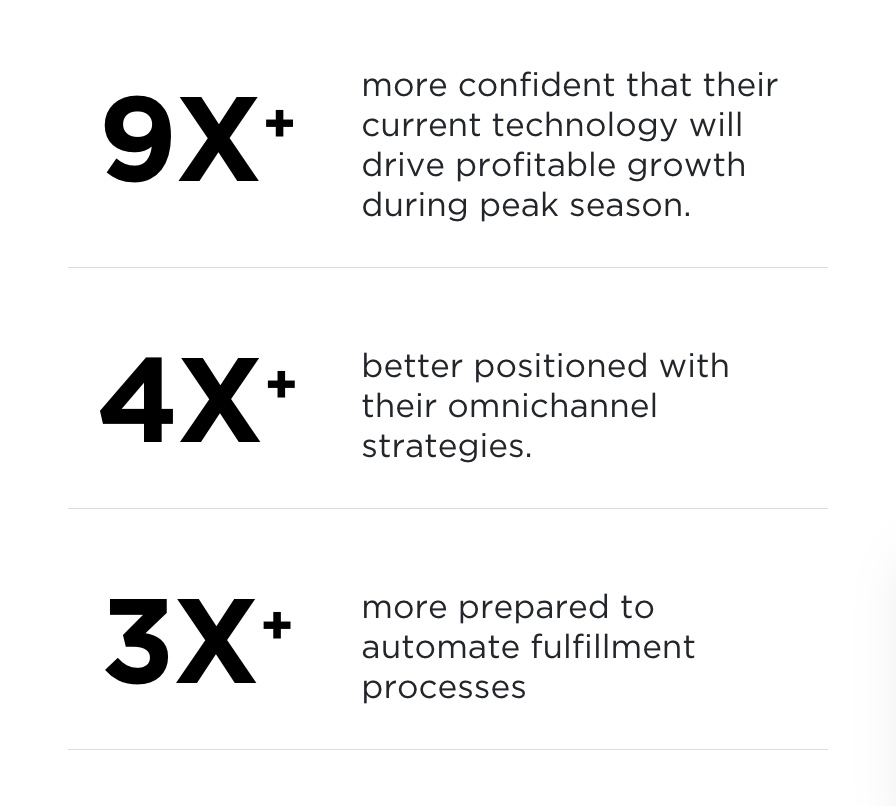We’re always comparing what we have to someone else. It could be buying clothes, a car, or WMS (warehouse management system) technology.
The business world is no different. We’re comparing shipping processes, new facilities… Also, the latest technology to make it happen.
- They just electrified their fleet
- Look at their new conveyance system
- Did you read their case study on a new WMS?
Peak season exposes a lot
Just as social media influences how you react personally, it has become just as influential on how you, as a business professional, consider your environment – which becomes broadly exposed during peak season!
- Are you keeping up with the market?
- How far behind have you gotten?
- How can you catch up quickly?
Related: Peak Season Planning Starts Now
While there is rarely a reason NOT to take advantage of new technology, the way you source, purchase, and deploy your WMS it is a different story.
Your timing and selection can make for a terrible experience. So it’s best to get an early start well ahead of your next seasonal crunch.
Let’s consider some of the things you’re dealing with and a better approach to adopting that new WMS or OMS software.
FOMO: Fear Of Missing Orders
Avoid trend-chasing
You open up LinkedIn and you see your competitor has a new and shiny WMS upgrade! New warehouse, new automation, new robots – oh my! You gotta catch up. They’ll capture the business you were targeting. You ALSO need to get robots in your warehouse.
But, why? Why do you need those robots? Did you have a use case, or are your operations trend-chasing?
It can be really hard to move past the solution to ensure there is a problem. There’s a reason closet-tech and shelf-ware are prevalent terms in our industry. You want to look progressive and buy aggressively, but you can easily lose sight of how the WMS or system add-on improves your specific supply chain. Is it improving anything or just accelerating a fundamentally bad design?
It’s easy to get excited about all the things you could do with that new inventory retrieval system, but if your business doesn’t have the right product catalog, you could be spending money with no clear payback timeline. You might end up worse off than you started.
Don’t be lured in when their marketing tells you their WMS deploys quickly and there has never been a bad deployment. As the old saying goes:
You can get it cheap, fast, or good; pick two.
Glossy ads will tell you that’s foolish; you can have it all, “Guaranteed or”… Or what?
The caveat emptor of WMS acquisition
The buyer should be aware… But of their own pressing need to not be left behind. When you trend chase, you stray from assessing your needs strategically. What was right for another firm might not be right for you.
Related: 6 Things WMS Software Companies Left Off Their Brochure
What gets left out of improvement stories is often the time involved.
- How long was the sales cycle?
- How long did it take to implement?
- How long did it take to get good at it?
As you deal with that immediate Fear of Missing Orders, remember it’s not as simple as picking up the phone and buying some software. It’s easy to fail to see the time to value – or lack of it – and focus only on curated gloss.
But while you’re chasing their success, your competition is off to the next improvement step. With increased market competition, you can’t afford to always be second because you are following someone else’s playbook.
If you’re always chasing, you can’t lead.
What’s the harm in waiting?
You don’t really need that WMS now. You’re doing just fine. You have people and systems that can adjust. Sure, there’s some strain, but that’s normal. Sure, there are some signs of strain, even breaks, but you’ve weathered this before. This peak will be no different.
Prevent the peak-season S.O.S.
The temptation to delay for a “better climate” is being seen throughout the market right now.
- I don’t really need that automation.
- I can just throw more people at the problem.
- The systems that got me here haven’t gone past their intended use.
The problem is that any part of the system – people, process, technology – accumulates strain.
Your people can flex beyond comfort, but only for so long. You start experiencing turnover, loss of tribal knowledge, and – in extreme cases – a persona as a bad environment for operations workers — blunting future recruiting.
Your processes were designed for a certain flow rate – floor and ceiling limits. Going beyond your control chart for too long manifests unpredictable habits.
Inventory cycle counts get progressively worse. More orders go out with defects. Returns increase and consumer confidence drops. Over time, reputational damage accumulates.
Your technology has a number of service hours, or volume processed, in its design. Nothing lasts forever. Even software has an ideal use case and throughput.
Is your information system keeping up? Are you seeing increased latency, more downtime, and increased maintenance? You can’t grow with a millstone on your operations team.
There is a multiplicative – not additive – effect to consider as well.
The Cost of Poor Performance is measured as a ‘per transaction’ value, but when you consider the physical – and mental – spillover, it’s more like water damage.
Process and technology issues frustrate your people. Tired, frustrated people make more process mistakes, leading to increased ‘Garbage In, Garbage Out’ within your systems. The water damage spreads, wearing down the operation.
Waiting for a dedicated WMS may be a sound financial decision, but not while the ship is taking on water.
Remain calm, slow down
You’ve got damage to undo and WMS technology to deploy!
You promised it yesterday; last year would be even better.
That’s not an excuse to jump in with something that looks good on paper but doesn’t address your short- and long-term needs.
Find true goodness of fit
Operational pains are acute and immediate and too often guide selection processes. Alleviation of pain can be excellent motivation but overlooks root causes and a thorough review of the business.
Present struggles also drown out forecasts for the future.
- Will these problems even exist next year?
- Are you making long-term acquisitions for one-off irritation?
- Are you considering WMS features you’ll need for next year’s program launches?
Catalog all your needs – past, present, and future – and be ready to challenge your WMS buying decisions with a true goodness of fit. It’ll make all the difference over a half-baked, quickly shelved gimmick.
Choosing the right solution for the right reasons means nothing if you botch the implementation. Most of the WMS shelf-ware mentioned previously was due to poor adoption. Workforces have a low tolerance for frustration and long memories.
Don’t expect the gap between demand awareness and solution go-live to be inconsequential. The desire to catch up, gain market parity, or even get out ahead can be maddening. Make sure you’re not making more problems than you’re solving in your desire for pain relief.
Choose just right
You need something, but beware of flashy emotional purchases.
Don’t just do nothing; be thoughtful in what you do.
Go slow, but not too slow.
WMS buying and adoption can be as much about threading a needle between too little and too much. Einstein said, “Make everything as simple as possible, but not simpler.” Start with your customer’s needs and identify the core things you need to address them. Don’t be hyped by innovation that won’t enable that mission.
Buy a WMS that’s built-for-purpose
You just solved peak season; now what?
Don’t want to go through another peak season ship-show? Take a look at Deposco’s WMS.
Our pure focus on ecommerce and Direct-to-Consumer (DTC) delivers a scalable WMS platform that doesn’t bulk out or create features that you don’t need.
We know that true time-to-value means not too little, not too much. It’s just right when you need an easier approach to navigating peak season.
Benefits of a just-right WMS
- The features you need to simplify immediate growing pains without overbuying
- No over-designed functionality, extra people, tons of billable hours, and lack of clear value add for you
- Made-to-order, not mass-produced: tailored to your needs, no changing your process to fit the limitations of the system
- One codebase and one vendor to guide rapid, clean system integrations that are not stitched together with your WMS
- A focused team dedicated to your growth and consistent funding in the areas you care about
A recent post-peak survey comparing our customers to non-Deposco users revealed our WMS as “the perfect fit”. Our customers are:
Request a demo to see what Deposco’s WMS can do for you.

